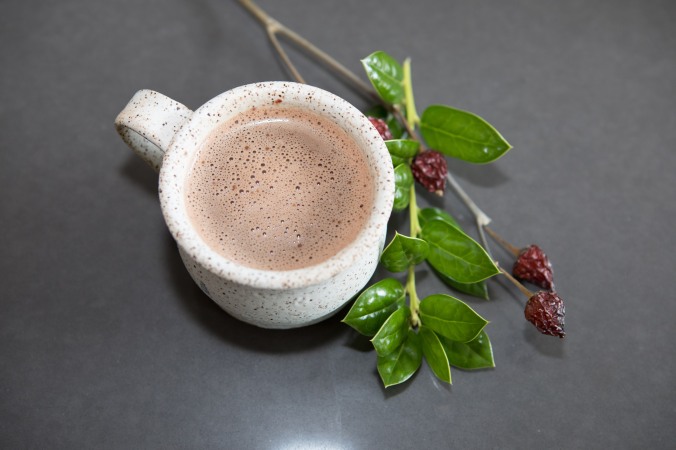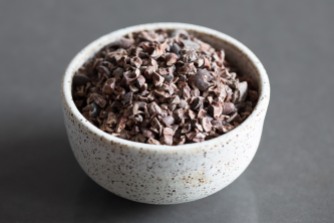This post presents the first recipe from a series of updated recipes that I developed for the Folger Shakespeare Library exhibition, First Chefs: Fame and Foodways from Britain to the Americas (on view Jan 19–Mar 31, 2019). You can also find a version of this post on the Folger’s Shakespeare and Beyond blog.
When pirate botanist William Hughes wrote about his adventures with plants in the Americas, he devoted an entire section of his book The American Physitian (1672) to “The Cacao Nut Tree,” which he distinguished from all other American plants. Hughes paid particular attention to the properties and the preparation of chocolate. In the opening of the section “Of the making of Chocolate into a Drink,” he calls the beverage “the American Nectar.”
By calling hot chocolate the “American Nectar” Hughes invoked the idea that chocolate was a drink consumed by deities, and pleasurable for those mortals lucky enough to sample it. Chocolate was a revelation to European colonizers. A decade before Hughes published his book, Henry Stubbe called chocolate the “Indian nectar.” British writers repeatedly appealed to its almost otherworldly properties.
Although there are no references to chocolate in Shakespeare’s works, there are quite a few references to nectar. Most poignantly, the potent flower that Puck wields in A Midsummer Night’s Dream contains a powerful nectar that intoxicates the anointed with powerful feelings of love (Act II, scene 2). A powerful nectar is equal parts pleasure and danger: Hughes chose an evocative moniker for his hot chocolate.
Encountering chocolate in early modern cookery books offers evidence of Britain’s troubled colonial past. Accounts of chocolate drinking, recipes listing chocolate among the ingredients, and casual references to chocolate all bear witness to the material and informational exchanges between indigenous peoples and European colonizers in the Americas. Theobroma cacao is a fragile equatorial plant and the seeds that we process into chocolate products are not, on first sight, obviously edible or the source of the dizzyingly delicious chocolate delights available today. Indigenous Americans prepared a range of healthful and delicious beverages with chocolate. Europeans only learned to consume chocolate by mastering highly specialized indigenous knowledge.
When I set out to make William Hughes’s hot chocolate, I was presented with a wealth of possibilities for how to sweeten, thicken, enrich, scent, spice, and spike my drink. Here is a list of all the ingredients that Hughes reports that indigenous peoples and European colonizers put in their hot chocolate:
…chocolate, milk, water, grated bread, sugar, maiz [corn flour], egg, wheat flour, cassava, chili pepper [hot and sweet varieties], nutmeg, clove, cinnamon, musk, ambergris, cardamom, orange flower water, citrus peel, citrus and spice oils, achiote [annatto seed], vanilla, fennel, annis, black pepper, ground almonds, almond oil, rum, brandy, [and] sack.
Some of these preparations could serve as a meal replacement, others as an energy drink, and yet others as a healing tonic to soothe the body. These possibilities are all present in indigenous American usage and Hughes catalogs them for his British readers. As you prepare your own hot chocolate using this recipe, season to taste. Let your own spirit of adventure and personal tastes guide you as you season your mix and prepare a warming cup.
THE RECIPE
Ingredients
This recipe makes 2 cups of hot chocolate mix.
1⁄4 cup cocoa nibs
3 1⁄2 ounces or 100 grams of a 70% dark chocolate bar, roughly chopped
1⁄2 cup cocoa powder
1⁄2 cup sugar
1 teaspoon vanilla
1⁄4 cup breadcrumbs or grated stale bread (optional for a thicker drink)
1⁄2 teaspoon chili flakes (substitute 1⁄2 teaspoon ground cinnamon for a less spicy drink)
Milk (1 cup of milk to 3 tablespoons of finished mix)
Preparation
Toast the cocoa nibs in a shallow pan until they begin to look glossy and smell extra chocolatey. Combine all ingredients in a food processor, blender, or mortal and pestle. Blitz or grind until ingredients are combined into a loose mix. Heat the milk in a pan on the stove or in a heatproof container in a microwave. Stir in three tablespoons of mix for each cup of heated milk.
Notes
Hughes lists many other ingredients that indigenous Caribbean people as well as Spanish colonizers added to their hot chocolate. Starting with a base of grated cacao, they thickened it with cassava bread, maize flour, eggs, and / or milk, and flavored it with nutmeg, saffron, almond oil, sugar, pepper, cloves, vanilla, fennel seeds, anise seeds, lemon peel, cardamom, orange flower water, rum, brandy, and sherry. Adapt this hot chocolate to your taste by trying these other traditional flavorings.

Photo by Teresa Wood
LEARN MORE
The information and ideas in this post about chocolate and the knowledge exchanges between Europeans and indigenous Americans are inspired by Marcy Norton’s Sacred Gifts, Profane Pleasures: A History of Tobacco and Chocolate in the Atlantic World (Cornell University Press, 2008).
See also:
Kuhn, John, and Marissa Nicosia, “Early Modern Euro-Indigenous Culinary Connections: Chocolate,” The Recipes Project.
Nicosia, Marissa, and Alyssa Connell, “Chacolet,” The Collation blog, Folger Shakespeare Library.
Tigner, Amy, “Chocolate in Seventeenth-Century England, Part I,” The Recipes Project.
This recipe was developed by Marissa Nicosia for the Folger exhibition, First Chefs: Fame and Foodways from Britain to the Americas (on view Jan 19–Mar 31, 2019), produced in association with Before ‘Farm to Table’: Early Modern Foodways and Cultures, a Mellon initiative in collaborative research at the Folger Institute.
Special thanks to Amanda Herbert and Heather Wolfe for their help.







I love the manicule!
Looking at how much work it takes to make a cup of hot chocolate from scratch has shown me just how spoiled I am with the mixes I can get at the grocery store. That said, old and slow is probably the best. The best cup of hot chocolate I ever had was went I was about 10 or 11. The power went out at our house and my mom made us kids hot chocolate by melting chocolate chips and heating milk on the wood stove. Nothing has ever come close since.
What a lovely memory! Thank you for sharing it. I hope you like this hot chocolate, too, but I doubt it will ever top that one.
Pingback: 4000 Years and Counting: A History of Drinking Chocolate | Dandelion Chocolate